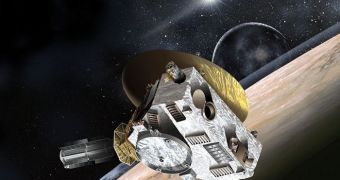As astronomers count down the years until a NASA spacecraft makes its way to the Kuiper Belt, many experts are currently making predictions about what the probe will find once it flies past the orbit of Pluto. The object is the cause of a dispute that has been raging on for about 5 years now.
Members of the International Astronomical Union (IAU) are divided over how to classify Pluto. While the prevailing view at one point was that the object is a dwarf planet, many now believe that it was wrongfully demoted from the fully-fledged planet status.
The heated debate is unlikely to quell until the NASA New Horizons spacecraft makes its way to the vicinity of the dwarf planet, in July 2015. At that point, the probe will carry out a flyby of Pluto and its four moons, establishing numerous aspects that existing telescopes cannot make out.
Even for the Hubble Space Telescope, observing the distant world is a nearly-impossible task. However, New Horizons is excellently equipped to take on the task. It carries redundancy in all of its primary and science systems, and is powered by an ion engine that makes it the fastest spacecraft ever.
At this point, the probe is traveling at a rate of about one million miles per day, yet is has more than four years to go until reaching the frigid world. Pluto is “actually a large place, about 5,000 miles around at the equator,” Alan Stern explains, quoted by SpaceRef.
“And it's never been explored,” adds the expert, who is the principal investigator for the New Horizons mission. He holds an appointment as an associate administrator at NASA, and was formerly based at the Southwest Research Institute (SwRI), in San Antonio, Texas.
“This is a whole new class of worlds. To understand the solar system, we need to understand worlds like Pluto,” he adds. This is becoming increasingly important as more and more dwarf planet-sized bodies are being discovered in the solar system. A total of 5 are now recognized by the IAU.
According to Stern, it may be that the Kuiper Belt is home to thousands of dwarf planets, some of which may be larger than Pluto, or even Eris. “Dwarf planets are, in fact, the most numerous class of planets in the solar system, and probably in the whole Universe,” he explains.
As New Horizons will approach Pluto, and open its instruments, it will begin taking a flurry of readings and images. The datasets that will be assembled in this manner will enable experts to compile projections on the nature of other dwarf planets.
By the time the spacecraft reaches Pluto, the Dawn space probe currently orbiting asteroid Vesta in the Inner Asteroid Belt would have already reached the dwarf planet Ceres. This means that astronomers will have two data sources for the same class of objects.

 14 DAY TRIAL //
14 DAY TRIAL //